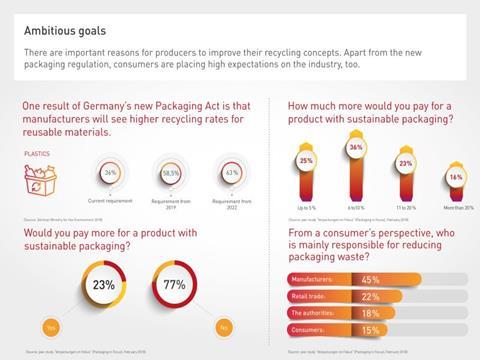
Experts are warning that there might be more plastic than fish swimming in the sea in 2050 – at the moment, 150 million tonnes of plastic are in the world’s oceans.
As Europe’s leading polluter of plastic waste, Germany has particular responsibility to bear. On average, every person in Germany throws away about 220 kg of plastic packaging each year. China’s ban on imports of certain types of waste, which has been in force since the start of 2018, is placing additional pressure on European manufacturers to cut their packaging waste. Up until that time, the People’s Republic was the biggest buyer of plastic waste – especially from trade and industry, such as commercial film, production scrap, rigid plastic and big bags – and not only for Germany.
New packaging legislation in Germany that will replace the current Packaging Ordinance beginning in 2019 is also changing these basic conditions. The new law will also boost recycling targets for producers. For instance, the recycling rate for plastic packaging is to rise from 36 per cent today to 63 per cent by 2022. TechBox Forum at this year’s FachPack will address the related challenges in greater detail in a series of lectures held on 27 September 2018.So there are compelling reasons for producers to prepare themselves for better recycling strategies. And plastic packaging’s poor public reputation is compounding matters.
Public pressureImages of islands of plastic in the oceans and growing environmental awareness among consumers mean that public calls for a new way of dealing with plastic packaging are becoming louder. The study “Packaging in Focus" carried out by the auditing and consulting firm pwc indicates that 94 per cent of consumers believe that less packaging material could be used in many products. Some 95 per cent of respondents also advocated reducing the amount of material to a minimum. An equally large number of people also called for the use of packaging material that is easy to recycle.
Consumers said that manufacturers (45 per cent) were first and foremost responsible for reducing packaging waste, followed by retailers (22 per cent) and legislators (18 per cent). Just 15 per cent of consumers feel that they bear the main responsibility. The proportion of consumers willing to spend more money on more sustainable packaging is therefore low: Only just under a quarter are open to paying higher prices. According to the study, these customers would accept an average mark-up of 16 per cent.
Cradle rather than graveHowever, a few hurdles stand in the way of practical implementation of a higher recycling rate. For instance, post-consumer waste, such as light-weight packaging material that is collected in a yellow bag in Germany, is hard to recycle. In most cases, this material is suitable only for recycling into lower-quality products. One reason for this is that plastic is not designed in accordance with the cradle-to-cradle principle but rather as cradle-to-grave products. For instance, composite materials are frequently used that involve a great deal of work to separate. In addition, labels and printing inks too often have a negative impact on material recycled from the ‘yellow bag’. The quality of packaging material could be maintained by using suitable technologies, thus also avoiding the loss of valuable raw materials.
Cradle to Cradle e.V., a group whose advisory board includes the pioneer of this design concept Dr Michael Braungart, calls for packaging that can be recycled into high-quality products rather than imposing bans and not using packaging in the first place. "For this to happen, packaging must be designed from the outset so that its components can easily be separated from one another and can be circulated after use in a closed loop," the association urges on its website.
No sooner said than done?For instance, the Recyclate Initiative launched by Werner & Mertz in 2012 advocates meaningful recycling of plastic waste from the ‘yellow bag’. This manufacturer of washing, cleaning and care products under the Frosch brand is now successfully making high-quality plastic packaging out of waste plastic from the ‘yellow bag’. These efforts are also focusing on sustainable labels and printing ink.
All manufacturers have to rethink their packaging strategy and can launch comprehensive measures to this end. They include closed-loop projects as the beverage trade has launched for PET bottles, for instance. The use of post-consumer waste is not impossible, either, as Werner & Mertz’s example shows. However, it is much harder to raise awareness among consumers of better recycling and to make them take responsibility. But alternatives to plastic packaging might be an option for several products when planning comprehensive measures. Exhibitors at FachPack will showcase a wide variety of packaging materials that make sure that products can be packaged in a sustainable way and without any loss of quality.











